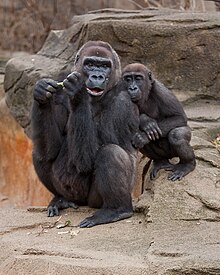Gorilla gorilla gorilla
| Western lowland gorilla | |
|---|---|
 |
|
| Male silverback western lowland gorilla at the Cincinnati Zoo | |
 |
|
| Female and juvenile at the Cincinnati Zoo | |
| Scientific classification | |
| Kingdom: | Animalia |
| Phylum: | Chordata |
| Class: | Mammalia |
| Order: | Primates |
| Suborder: | Haplorhini |
| Family: | Hominidae |
| Genus: | Gorilla |
| Species: | G. gorilla |
| Subspecies: | G. g. gorilla |
| Trinomial name | |
|
Gorilla gorilla gorilla (Savage, 1847) |
|
| NCBI genome ID | 2156 |
|---|---|
| Ploidy | diploid |
| Genome size | 3,035.66 Mb |
| Number of chromosomes | 23 pairs |
| Year of completion | 2012 |
The western lowland gorilla (Gorilla gorilla gorilla) is one of two subspecies of the western gorilla (Gorilla gorilla) that lives in montane, primary and secondary forests and lowland swamps in central Africa in Angola, Cameroon, Central African Republic, Republic of the Congo, Democratic Republic of the Congo, Equatorial Guinea and Gabon. It is the gorilla most often found in zoos.
The western lowland gorilla is the smallest subspecies of gorilla but nevertheless still a primate of exceptional size and strength. This species of gorillas exhibits pronounced sexual dimorphism. They possess no tails and have jet black skin along with coarse black hair that covers their entire body except for the face, ears, hands, and feet. The hair on the back and rump of males takes on a grey coloration and is also lost as they get progressively older. This coloration is the reason why older males are known as "silverbacks". Their hands are proportionately large with nails on all digits, similar to that of a human's, and very large thumbs. They have short muzzles, a prominent brow ridge, large nostrils, and small eyes and ears. Other features are large muscles in the jaw region along with broad and strong teeth. Among these teeth are strong sets of frontal canines, and large molars in the back of the mouth for grinding vegetables.
A male standing erect can be 1.5–1.8 m (4 ft 11 in–5 ft 11 in) tall and weigh 140–270 kg (310–600 lb). According to the Guinness Book of World Records, the average male is 168 kg (370 lb) and stands upright at 163 cm (64 in). Males in captivity, however, are noted to be capable of reaching weights up to 275 kg (606 lb). Females stand 1.5 m (4 ft 11 in) tall and weigh half as much as males. According to the late John Aspinall a silverback gorilla in his prime has the physical strength of seven or eight Olympic weightlifters, but this claim is unverified. Western gorillas frequently stand upright, but walk in a hunched, quadrupedal fashion, with hands curled and knuckles touching the ground. This style of movement requires long arms, which works for western gorillas because the arm span of gorillas is larger than their standing height. The average size of the male western lowland gorilla's reproductive organ is typically between 30–40 cm (12–16 in) inches long, and it stops growing after a few years of agecitation needed.
...
Wikipedia

